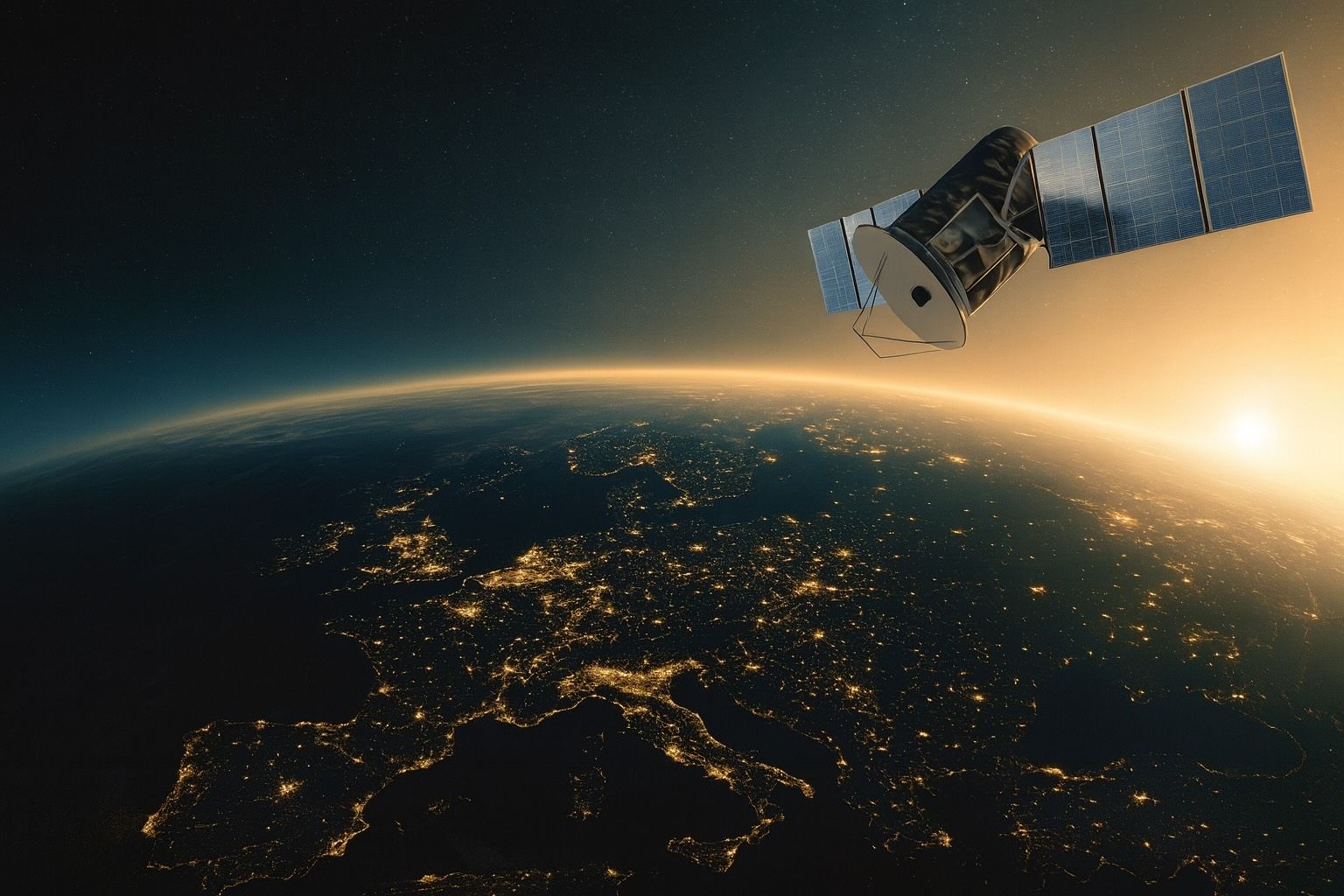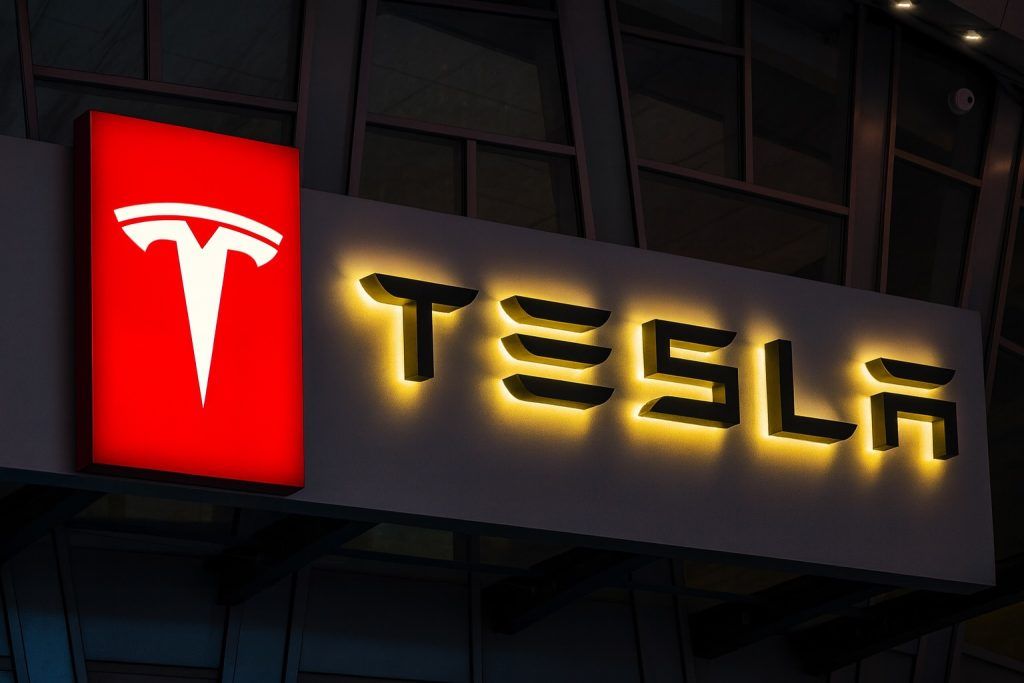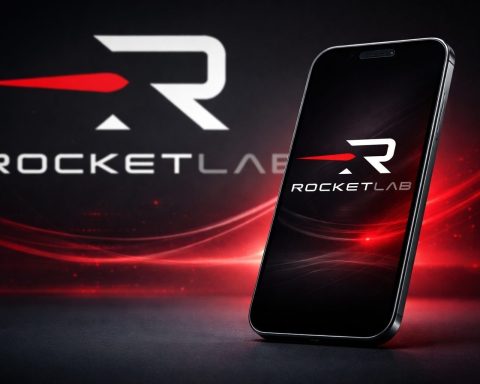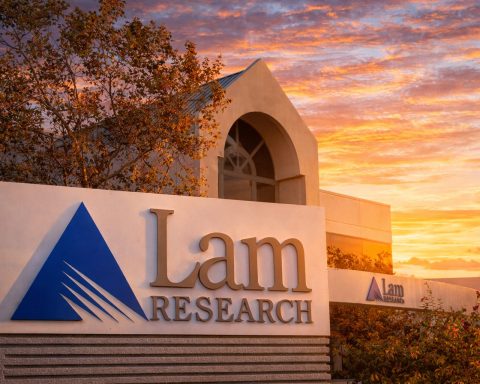- European Aerospace Giants Unite: Airbus, Thales, and Leonardo have agreed to merge their satellite manufacturing and space services businesses, creating a joint venture with €6.5 billion in annual revenue and 25,000 employees [1]. Airbus will own 35% of the new entity, with Thales and Leonardo each holding 32.5% under a “balanced governance” structure [2] [3]. The new company (unnamed so far) is expected to launch operations by 2027, pending regulatory approvals [4] [5].
- Goal: Counter Starlink’s Dominance: This alliance – the largest space industry consolidation in Europe in decades – aims to “pool…loss-making” satellite units and “counter the runaway growth” of competitors led by Elon Musk’s SpaceX (Starlink) [6]. Europe’s top satellite makers have been dwarfed by the shift to low-Earth-orbit megaconstellations like Starlink’s, which now has ~8,500 satellites (about two-thirds of all active satellites in orbit) [7].
- Strengthening European Autonomy: The three CEOs call the merger a “pivotal milestone for Europe’s space industry,” saying it will build a stronger European player to compete globally and ensure Europe’s autonomy in the strategic space domain [8]. The combined company will unite the full spectrum of space capabilities – from satellites to ground services (excluding launchers) – leveraging each partner’s expertise (e.g. Thales Alenia Space, Telespazio, and Airbus’s space division) [9] [10].
- Synergies & Growth Prospects: By joining forces, the firms expect to achieve significant efficiencies. The venture is projected to generate “mid-triple-digit million” euro annual synergies in operating income within five years of closing [11]. It also comes with over three years of order backlog already booked [12]. The companies believe the deal will unlock new revenue opportunities, foster innovation (through combined R&D), and position Europe to win big projects like the EU’s planned IRIS² satellite network (290 satellites by 2027) [13] – rather than ceding that market to foreign rivals.
- Investor Reaction: Markets have responded positively. Leonardo’s stock jumped, topping Italy’s FTSE MIB index after the announcement, as investors welcomed the creation of a “European satellite giant” to rival SpaceX [14]. Analysts note that consolidating these businesses could stop financial losses in Europe’s satellite sector and eventually boost profits via cost-sharing and greater export competitiveness. Airbus and Thales shares also saw modest gains, with the deal viewed as a long-term strategic win for all three companies (Airbus will even receive a compensatory payment for capping its stake at 35% despite contributing ~50% of revenues) [15].
Europe Builds a Space Powerhouse to Take on Starlink
Europe is finally uniting its space champions. In a landmark agreement announced on October 23, aerospace giants Airbus, Thales, and Leonardo unveiled plans to combine their satellite divisions into a single joint venture worth €6.5 billion in annual sales [16]. The move wraps up months of negotiations (code-named “Project Bromo”) and seeks to create a European “one-stop-shop” for satellites and space systems that can compete with Elon Musk’s Starlink megaconstellation and other rivals [17]. It’s a strategic play to regain ground in the global space race, where Europe’s once-leading satellite firms have fallen behind the explosive growth of U.S. and Chinese players.
Under the preliminary Memorandum of Understanding (MoU), the new company will be jointly controlled by the three partners, with Airbus holding 35% and Thales and Leonardo 32.5% each [18]. This slightly unequal split reflects Airbus’s larger current space business, but the governance will be balanced so that none of the companies dominates [19]. In fact, Airbus agreed to limit its stake to 35% and will receive compensation from the others for doing so, given that Airbus’s unit accounts for roughly half of the total revenue of the combined entity [20]. All three firms will contribute assets to the venture: Airbus brings its entire Space Systems and Space Digital divisions (from Airbus Defence and Space), Leonardo contributes its Space unit including its stakes in Telespazio and Thales Alenia Space, and Thales contributes its stakes in Thales Alenia Space, Telespazio, plus its small Thales SESO space optics unit [21]. In effect, the deal consolidates almost all of Europe’s satellite manufacturing and related services into one entity – a new space behemoth with 25,000 employees across nearly 30 sites in Europe [22].
The partners have set 2027 as the target for the new venture to be fully operational [23]. That timeline gives them time to obtain regulatory approvals and iron out integration details. Notably, EU antitrust regulators have in the past resisted such consolidation in the aerospace/defense sector, worrying about reduced competition [24]. However, this time the political wind is in favor of building a “European champion.” The companies – and their governments – are expected to argue that the real competition is global (from SpaceX, China, etc.), and that Europe needs scale to survive. Indeed, Airbus and Leonardo have already urged EU regulators to take a broad global view when assessing the merger, rather than focusing narrowly on intra-European competition [25]. The analogy often cited is MBDA, the European missile consortium that France, Italy and the UK formed in 2001 by merging national missile makers [26] [27]. That joint venture (Airbus, BAE Systems, Leonardo as shareholders) successfully created a pan-European leader in missiles – and now Airbus, Thales, and Leonardo hope to replicate that model in the space sector [28].
Officials and industry leaders are hailing the alliance as a necessary step. “This proposed new company marks a pivotal milestone for Europe’s space industry,” said Airbus CEO Guillaume Faury, Leonardo CEO Roberto Cingolani, and Thales CEO Patrice Caine in a joint statement, adding that it “aligns with the ambitions of European governments…ensuring Europe’s autonomy across the strategic space domain” [29]. In other words, Europe wants to secure independent ability to design, build, and operate advanced satellites – for communications, navigation, Earth observation, defense, etc. – without being reliant on foreign providers. The Ukraine war underscored this concern: Starlink (operated by a U.S. company, SpaceX) became critical infrastructure for communications, raising eyebrows in European capitals about over-reliance on non-European networks. Strengthening Europe’s own space tech is seen as a matter of sovereignty.
Why Starlink’s Shadow Looms Large
The catalyst for this merger is the tectonic shift in the satellite industry over the past few years. Traditionally, European firms like Airbus and Thales Alenia Space led the world in building large geostationary satellites – the kind used for television broadcast, weather observation or military communications – often bespoke, high-cost craft built in the dozens. But along came SpaceX’s Starlink, with its paradigm of launching thousands of small, low-cost satellites into low Earth orbit (LEO) to provide global internet service. In just a few years, Starlink has deployed an unprecedented fleet – over 8,000 satellites to date, accounting for about “two out of every three” active satellites now in orbit [30]. This megaconstellation model drastically lowers unit costs through mass production and rapid launch cadence (SpaceX is launching hundreds of Starlink satellites per month). It also shifts demand away from the expensive one-off satellites that European industry excelled at.
For Europe’s satellite makers, the Starlink revolution was disruptive. Airbus and Thales Alenia Space found themselves with fewer commercial orders for traditional satellites, while lacking a competitive LEO product of their own. Their finances suffered – Airbus’s space division racked up heavy losses and even cut ~2,000 jobs in recent years [31], and Thales/Leonardo’s joint ventures have also struggled (Reuters notes the businesses being merged were “loss-making” as stand-alone entities) [32]. Meanwhile, U.S. and Chinese competitors forged ahead: Amazon is preparing its Project Kuiper constellation (over 3,000 LEO satellites planned), and China’s state-backed players are planning massive LEO networks as well [33] [34]. “Europe’s top satellite firms…have been dwarfed” by these tech rivals and the new market reality of cheap LEO constellations [35].
By 2022, alarm bells were ringing in European capitals. The EU announced a €6 billion program for a sovereign satellite network called IRIS² (Infrastructure for Resilience, Interconnectivity and Security by Satellite) – a planned constellation of ~290 satellites to be deployed by 2027, intended to rival Starlink in secure communications for Europe [36] [37]. The IRIS² project is being led by a consortium including France’s Eutelsat (which itself merged with Britain’s OneWeb, another nascent LEO constellation). Notably, many of OneWeb’s first-generation satellites were built by Airbus, and its next-gen satellites for IRIS² will likely be a key contract the new alliance hopes to win. Europe clearly doesn’t want to leave critical connectivity in the hands of SpaceX; demand for “sovereign broadband” is peaking, and Europe wants its own systems [38].
Industry experts long argued that Europe’s fragmented approach – with multiple national companies duplicating efforts – was untenable in the face of SpaceX’s scale. Roberto Cingolani, Leonardo’s CEO, warned repeatedly that without collective action, Europe risked irrelevance in both defense and space. He noted Europe invests only about €20 billion/year in aerospace, versus $250 billion by the U.S. (public and private) [39]. “Coordinating alliances between industry and the state is the only viable strategy to compete in a context dominated by satellite constellations and global interconnections,” Cingolani said, urging a leap in scale and pan-European cooperation [40]. Even government officials pushed for ego aside: Italy’s then Defense Minister Guido Crosetto insisted the issue was “industrial capacity, not politics,” prodding the French and Italian stakeholders to find common ground rather than protect national turf [41].
Those warnings were echoed by analysts. If Europe delayed, it could be forced to depend on American or Chinese satellite networks for connectivity and miss out on a booming market. As one analysis put it, “schedule slippage could leave Europe dependent on U.S. or Chinese constellations just as demand for sovereign broadband peaks” [42]. In short, it was now or never for a grand merger. That urgency overcame obstacles that had stalled similar ideas in the past (antitrust fears, nationalist rivalry, disagreements over who leads). The result is this alliance – essentially a European mega-consolidation – which would have been politically unthinkable a decade ago, but is now seen as vital for survival.
Inside the Mega-Merger: Stakes, Savings and Strategy
The combined space venture will encompass a wide range of activities: designing and manufacturing satellites (from large military satellites to small cubesats), ground systems and control centers, satellite operations services, and more – essentially covering the whole value chain except launch rockets [43]. By uniting their portfolios, Airbus, Thales and Leonardo say the new company will be able to offer “end-to-end solutions” and integrated services that none of them could provide alone [44]. This should make them more competitive in export markets, where they’ll face not only SpaceX but also U.S. firms like Lockheed Martin, and up-and-coming players from China and elsewhere.
Crucially, the merger is expected to bring economies of scale. The companies estimate it will yield hundreds of millions of euros in annual cost savings (synergies) within a few years [45]. Overlapping projects can be streamlined, R&D efforts pooled, and production optimized across the new entity’s multiple facilities. For example, instead of Airbus and Thales Alenia Space separately developing similar satellite platforms, the JV can consolidate around one product line and avoid internal competition. The “mid-triple digit million” euro savings target (likely €500–700 million per year by ~2032) is ambitious, but if achieved, it could swing these space units back to profitability [46]. The companies also see revenue synergies – by combining their technological strengths they can pursue larger contracts and “lead innovative programs” that require a unified front (such as European government projects or large constellations for telecom operators) [47] [48].
Job impact is a sensitive topic. European aerospace unions have been wary that mergers often lead to layoffs. All three firms’ space divisions have already undergone restructuring – in total around 3,000 jobs were cut in recent years as the market shifted to LEO satellites [49]. The new alliance stated that it has “made no mention” of further job cuts and will consult with unions moving forward [50]. Since the aim is to grow and innovate, not shrink, the CEOs even pitch the merger as benefiting employees by offering broader career opportunities “through [the] extensive multinational footprint of the new company” [51]. Still, workforce integration will be complex: blending cultures from France, Italy, Germany, UK and other countries where each partner has space facilities. Political scrutiny will ensure that workshare is spread in a “fair” way – likely each nation will want a slice of high-tech jobs. France and Italy, in particular, will share leadership roles (Thales’s CEO Patrice Caine is one architect of the deal, while Leonardo will seek strong representation to safeguard Italian interests) [52] [53]. The governance details (who holds CEO/CFO positions in the JV, etc.) have been closely negotiated to keep everyone satisfied [54].
Another challenge is getting regulatory clearance. As noted, past attempts to merge these businesses stumbled over EU antitrust concerns and nationalist vetoes [55] [56]. This time, however, there is strong political backing from the French and Italian governments – a recognition that Europe needs this merger. Smaller EU countries or companies might object (Germany’s OHB, a niche satellite maker, has voiced concern about being squeezed out by an Airbus-Thales-Leonardo behemoth) [57]. Regulators will weigh those issues, but given the global context and Europe’s strategic autonomy goals, most analysts expect the deal to be approved in some form. It’s telling that EU Commissioner Thierry Breton (in charge of space and industry) has championed building EU constellations and strengthening the industry, so the political climate is favorable. The transaction is structured as a joint venture with joint control (rather than a full acquisition by one company), which may help its case by showing it’s a partnership “with a balanced governance structure” rather than an anti-competitive takeover [58].
If all goes to plan, the new space giant will formally launch by 2027. That timing is significant: it aligns with the deployment schedule of IRIS², the EU’s secure satcom constellation. The JV will be well-positioned to bid on IRIS² contracts and other big projects – something the companies likely coordinated with EU officials. In their announcement, the CEOs emphasized that the alliance “offers governments a trusted partner” for future sovereign space programs [59] [60]. In other words, Europe now has a single champion in satellites, much like Airbus is the European champion in airliners. The hope is that a unified entity can achieve “critical mass” to compete globally – in technology, scale and price [61] [62].
Market Reactions and Future Outlook
Investors have generally cheered the announcement, seeing it as a long-term positive for the companies involved. Leonardo, the Italian defense and aerospace firm, saw an immediate boost: its shares “benefit from the alliance” and jumped enough to make Leonardo the top performer on Milan’s stock index on Oct 23 [63]. This reflects optimism that Leonardo (the smallest of the trio by revenue) will gain from partnering with larger players and accessing a broader market. Notably, Leonardo’s stock had already been climbing in anticipation of the deal – in the days leading up to the announcement, it “soared” ahead of the alliance with Thales and Airbus, according to market observers [64]. Investors likely expect the merger to eventually improve Leonardo’s earnings, since its space segment (through joint ventures) had been underperforming.
Thales, the French electronics and defense group, is also seen as a winner: merging Thales Alenia Space (67% owned by Thales) and related services into the JV should remove a drag on Thales’s overall margins (space was a relatively low-margin business). Thales will own about a third of a more efficient, larger venture instead of 100% of a smaller struggling unit. Airbus, Europe’s aerospace titan, arguably has the most to gain strategically – it will offload a portion of its space division’s costs while still retaining a leading role (35%) in the new company, and it gets a cash infusion via balancing payments [65]. Airbus investors have long focused on the booming commercial jetliner business; for them, reducing Airbus’s exposure to the volatile satellite market could be a relief. All three stocks – traded in Paris, Milan – have outperformed in recent weeks amid speculation of this deal coming together.
Looking ahead, the big question is whether combining forces will indeed deliver the intended results. The track record of large mergers is mixed: synergies can prove elusive and integration can be bumpy. However, this case has some advantages. Each partner brings complementary pieces (for example, Airbus is strong in telecom satellites and small constellations, Thales Alenia Space in science and navigation satellites, Leonardo’s Telespazio in operations services). There is a clear common enemy – Starlink and other foreign rivals – which gives the alliance focus. Governments are also likely to support the venture with contracts and funding (the EU’s space budget and national space programs could preferentially flow to the new champion). A European official quoted by Il Sole 24 Ore called the alliance “a new colossus” with the heft to “compete for global leadership” in space, indicating high expectations [66].
Some analysts forecast that by the late 2020s, this merged entity could even pursue an IPO (initial public offering) or become a more independent corporation, much like Airbus itself evolved from a consortium. For now, the three parent companies will share control and profits. The new venture is expected to be self-financing, and with an order backlog over 3 years of sales already [67], it has a solid runway. If it executes well, Europe’s space giant could start winning a bigger slice of the commercial market (e.g. building satellites for other nations or internet providers) – not just relying on European institutional projects. The global space economy is projected to surge over the next decade (Morgan Stanley estimates $1 trillion by 2040), so there is ample opportunity if the company can become competitive on price and innovation.
On the flip side, the venture will need to radically innovate to catch up in the LEO constellation game. SpaceX’s Starlink enjoys a huge first-mover advantage and continues to launch at breakneck pace. Amazon’s Kuiper is coming online soon. OneWeb (now combined with Eutelsat) is another player, though more niche. The European JV might consider developing its own constellation offerings (beyond IRIS²) to sell broadband services, or it might focus purely on manufacturing satellites for others. Staying at the cutting edge of technology – such as satellite mass production, AI-driven communications, and next-gen secure communications – will determine its success. The companies have cited the ability to “invest in future space products and services” together as a key goal [68]. Merging R&D budgets could indeed help them afford breakthroughs (for example, in satellite miniaturization or advanced antennas) that none would risk funding alone.
Europe’s new space alliance also carries symbolic weight. It shows that Europe is “striking back” in the space race, rather than passively watching Silicon Valley and Beijing take the lead. “Growth in scale and speed” is needed to face the American onslaught, Airbus’s Faury had stressed [69] – and scale is exactly what this merger is about. It is a bold bet on collaboration over competition within Europe. As the three CEOs put it, by “pooling our talent, resources [and] expertise…we aim to generate growth, accelerate innovation and deliver greater value” [70]. Achieving those aims will not happen overnight; the fruits of this combination will likely appear only in a few years once integration is complete and new programs are won. But if successful, the payoff could be significant: a European space conglomerate capable of going toe-to-toe with the likes of SpaceX, Lockheed Martin, or China’s CASC in the fast-evolving satellite industry.
For now, the deal’s announcement marks a historic turning point. It’s the clearest sign yet that Europe is not willing to cede the “new space” era to others. By uniting Airbus, Thales, and Leonardo’s space know-how, the continent is consolidating its strengths to remain a force in orbit. As one industry union cautioned, simply merging companies isn’t a panacea – it must be accompanied by a robust European space strategy [71]. But with this alliance and initiatives like IRIS², such a strategy is visibly taking shape. The message to SpaceX and other competitors is that Europe is gearing up for the fight. Elon Musk himself reacted to the news with a trademark quip on X (Twitter), joking that Starlink “welcomes the competition” – a nod to the fact that competition will only spur more innovation across the board. For consumers and governments, that could be a win-win: more choices and resilience in satellite services. And for Europe, it’s a step toward securing a place at the high table of the burgeoning space economy, rather than being left behind in the Starlink era.
Sources:
- Reuters – “Europe firms agree satellite merger to counter Starlink” (Oct 23, 2025) [72] [73] [74] [75]
- Reuters – “European satellite merger looms as Leonardo board meets” (Oct 21, 2025) [76] [77] [78]
- Airbus Press Release – “Airbus, Leonardo and Thales sign MoU to create a leading European player in space” (Oct 23, 2025) [79] [80]
- TS2 Technology News – Space industry updates (June 24 & Oct 5–6, 2025) [81] [82] [83]
- FirstOnline (Italy) – Market report (Oct 23, 2025) [84] (Leonardo stock reaction)
- Decode39 – “Space: Airbus, Thales and Leonardo move toward an alliance” (Sept 16, 2025) [85] [86]
References
1. www.reuters.com, 2. www.reuters.com, 3. www.reuters.com, 4. www.reuters.com, 5. www.airbus.com, 6. www.reuters.com, 7. ts2.tech, 8. www.airbus.com, 9. www.reuters.com, 10. www.airbus.com, 11. www.reuters.com, 12. www.airbus.com, 13. ts2.tech, 14. www.firstonline.info, 15. www.reuters.com, 16. www.reuters.com, 17. www.reuters.com, 18. www.reuters.com, 19. www.reuters.com, 20. www.reuters.com, 21. www.airbus.com, 22. www.reuters.com, 23. www.reuters.com, 24. www.reuters.com, 25. www.reuters.com, 26. www.reuters.com, 27. www.reuters.com, 28. www.reuters.com, 29. www.airbus.com, 30. ts2.tech, 31. www.reuters.com, 32. www.reuters.com, 33. ts2.tech, 34. ts2.tech, 35. www.reuters.com, 36. www.theguardian.com, 37. ts2.tech, 38. ts2.tech, 39. decode39.com, 40. decode39.com, 41. ts2.tech, 42. ts2.tech, 43. www.airbus.com, 44. www.airbus.com, 45. www.reuters.com, 46. www.reuters.com, 47. www.airbus.com, 48. www.airbus.com, 49. www.reuters.com, 50. www.reuters.com, 51. www.airbus.com, 52. www.reuters.com, 53. www.reuters.com, 54. www.reuters.com, 55. www.reuters.com, 56. www.reuters.com, 57. www.reuters.com, 58. www.reuters.com, 59. www.airbus.com, 60. www.airbus.com, 61. www.airbus.com, 62. www.airbus.com, 63. www.firstonline.info, 64. www.firstonline.info, 65. www.reuters.com, 66. www.repubblica.it, 67. www.airbus.com, 68. www.airbus.com, 69. decode39.com, 70. www.airbus.com, 71. www.reuters.com, 72. www.reuters.com, 73. www.reuters.com, 74. www.reuters.com, 75. www.reuters.com, 76. www.reuters.com, 77. www.reuters.com, 78. www.reuters.com, 79. www.airbus.com, 80. www.airbus.com, 81. ts2.tech, 82. ts2.tech, 83. ts2.tech, 84. www.firstonline.info, 85. decode39.com, 86. decode39.com










